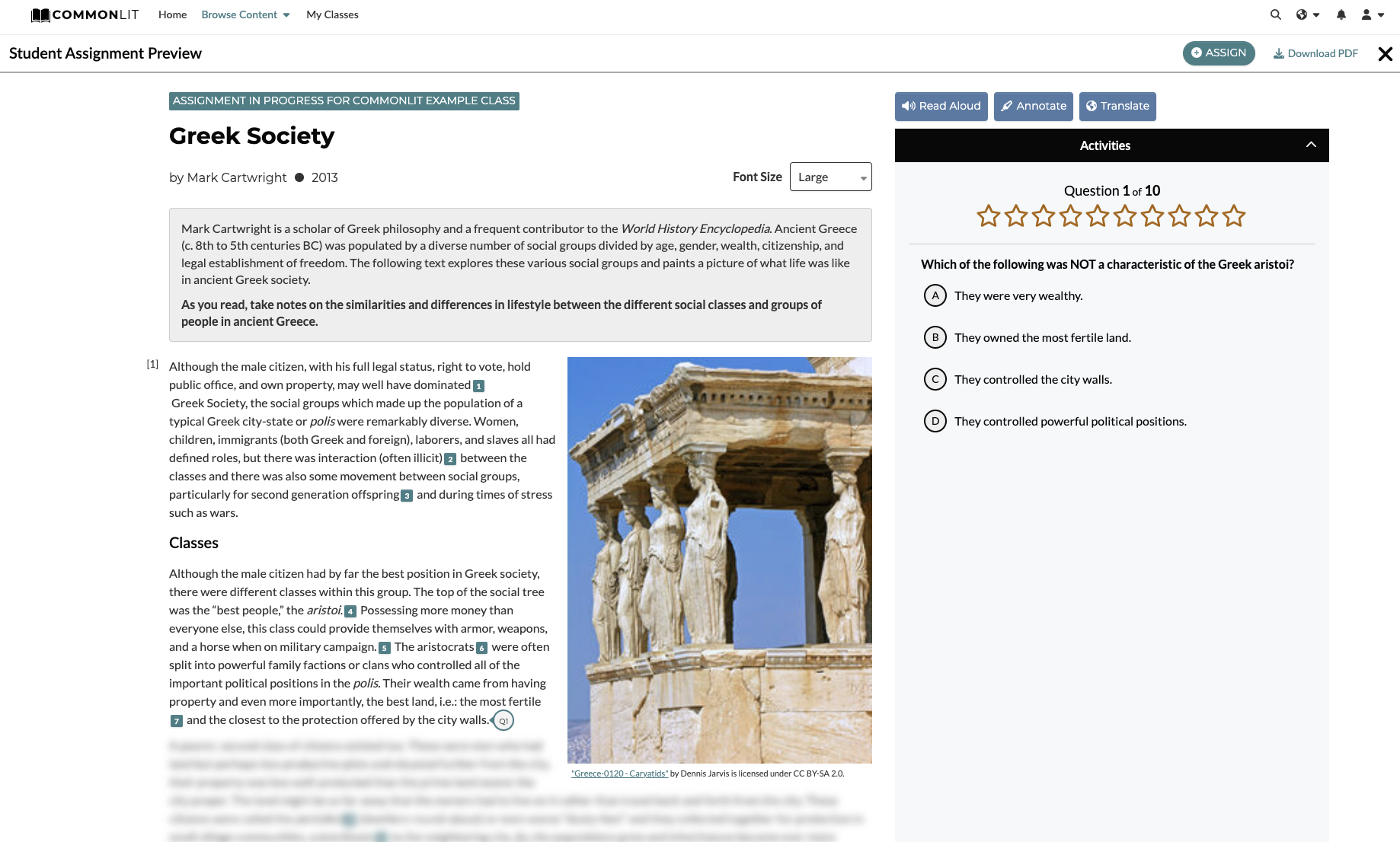 Secondary Classrooms
Don’t Get Lost in the Odyssey: Use Reading Lessons from CommonLit to Boost Students’ Reading Comprehension and Engagement
Secondary Classrooms
Don’t Get Lost in the Odyssey: Use Reading Lessons from CommonLit to Boost Students’ Reading Comprehension and Engagement
These high interest informational texts, poems, and short stories are the perfect complement to a unit of ELA instruction focused on The Odyssey.
CommonLit’s digital literacy program features over 3,000 reading lessons complete with standards-aligned comprehension questions, discussion questions, and lesson planning ideas for teachers! These lessons are proven to help students build reading comprehension skills and are a great add-on for any ELA curriculum.
In addition to our individual reading lessons, CommonLit’s online reading program also offers Book Pairings. These are sets of texts curated to compliment novel-based instruction.
Today, we’ll be diving into CommonLit’s Book Pairings for Homer’s epic poem The Odyssey. The Odyssey is an epic poem that has been handed down for centuries since Homer’s time in Ancient Greece. The text chronicles the journey of Odysseus, an ancient Greek war hero, attempting to travel home to Ithaca. The twenty-year journey is full of tests and twists that are sure to spark student interest!.
Support Students’ Schema with Knowleding-Building Informational Texts
CommonLit offers two informational texts to provide additional background knowledge for students. These informational texts provide insights into the psychological aspects of resilience and societal structures in Ancient Greek society in order to prepare students to fully delve into Homer’s complex and rigorous text.
“How Resilience Works” by Diane Coutu (11th grade)
This informational text discusses the three main traits of resilience and the role resilience plays in success and survival.
Have students read this text after finishing Book 2 of The Odyssey, when Penelope’s shroud weaving trick is revealed. As students read the text, have them trace the author’s claim. Later on, ask them, “Of the three components that Coutu names which best explains Peneloope’s use of the shroud to keep the suitors at bay?”
“Greek Society” by Mark Cartwright (10th grade)
This informational text explores the various tiers of ancient Greek society, as well as how class, age, and gender affected people’s daily lives. This will give students insight into Homer’s characterization throughout The Odyssey, particularly that of the suitors.
Have students read this text after reading Books 21 and 22 to build background knowledge. Ask students to consider, “What role did social hierarchies play in a person’s choices and role in life? How easy was it for a person to move within the social strata?”
Consider turning on CommonLit’s Guided Reading Mode. This tool helps students identify the main ideas of the text as they read.

Expand on Themes Central to The Odyssey
Homer’s text considers rich themes such as youth, arrogance, and aging. Here are some additional text pairings from our digital library to enhance students’ reading comprehension and push them to consider the literary themes of The Odyssey on an even deeper level.
“The Story of David and Goliath” from The Book of Samuel (8th grade)
In this translation from the New King James Version Bible, the young and small shepherd, David, takes up the giant enemy warrior Goliath’s challenge for battle. In a true underdog fashion, David beats Goliath.
Have students read and analyze the conflict in the text “The Story of David and Goliath” after completing Book 9. Compare and contrast Goliath and Polyphemus and David and Odysseus. Ask students, “What evidence is there that David was confident but not arrogant? On the contrary, what evidence is there that Odysseus is both confident and arrogant?”
“Nothing Gold Can Stay” by Robert Frost (9th grade)
In this poem, a speaker describes the fleeting nature of youth and beauty: “So Dawn goes down to day. / Nothing gold can stay.”
Have students read the poem after reading Book 6, which introduces the character of Nausicaa and her encounter with Odysseus on the beach. Ask students to consider the following: “In Frost’s poem, how does he characterize youth? What imagery does he use to support this characterization? In comparison, which imagery does Homer use to depict Nausicaa’s youth?”
Analyze Comparative Symbols through Modern Texts
Our last two pairings offer students the opportunity to dive into modern texts that highlight the specific literary device of symbolism. As students compare more modern symbols with those in The Odyssey, they not only deepen their reading comprehension of the Classic, ancient text, but also gain a deeper understanding of the specific literary device.
“The Necklace” by Guy de Maupassant (9th grade)
In this short story, a poor woman borrows an expensive necklace for a fancy ball. When the necklace goes missing, the woman and her husband spend years living in poverty in order to pay back that debt.
Have students read this text after reading Book 12, where Odysseus listens to the Siren’s song, in order to examine the relationship between symbolism and theme. Ask students, “How do both the necklace and the Siren’s song function symbolically to represent the danger of desire?”
“The Roof of Leaves” by Donna L. Washington (6th grade)
This short story features a Congolese husband and wife who are able to save their marriage due to quick thinking after a fight and serves as a wonderful character comparison to Odysseus’s wife, Penelope.
Have students read this after reading Book 23 in order to examine character and symbolism. Ask students, “Why are the Congolese wife and Penelope compelled to be clever? What was at stake that each wife was trying to protect? Why might the preservation of marriage require such nimble thinking?”
Bonus!
Looking for more paired texts to support your student’s reading comprehension growth? CommonLit’s online library offers book pairings for over 100 commonly taught novels as well as hundreds of reading lessons focused on informational texts to build background knowledge for your students. Check out the text set focused on Ancient Greece!
Next Steps
Want more great text suggestions? Check out our free webinars, featuring seasonal text selections and more!

